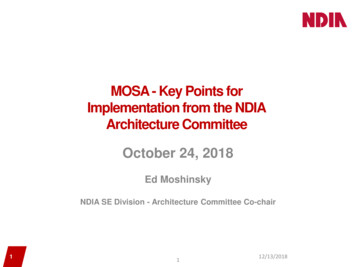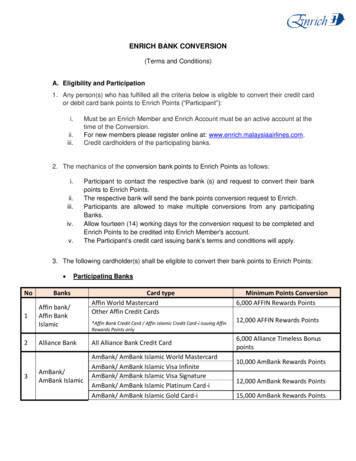
Transcription
MOSA - Key Points forImplementation from the NDIAArchitecture CommitteeOctober 24, 2018Ed MoshinskyNDIA SE Division - Architecture Committee Co-chair1112/13/2018
Topics NDIA Architecture Committee Overview Modular Open Systems Approach (MOSA)– Overview and Drivers Key MOSA Concepts and Challenges––––Methodology ConceptOpenness of InterfacesArchitecting for ModularitySystem Group/ Taxonomies Considerations MOSA White Paper Organization Top 10 Committee Recommendations2www.incose.org/symp2018
NDIA Architecture Committee Overview National DefenseIndustrial Association(NDIA)“Promotes the best policies, practices,products and technology to build a moreresponsive and collaborative community insupport of defense and national security” NDIA SE Division (orgchart) ArchitectureCommittee - key focuson MOSA––3MOSA white paper to bepublished in coming months;co-authors are welcome tojoinThis presentation captureskey points from theCommittee’s workNational Defense Industrial AssociationSYSTEMS ENGINEERING DIVISIONSteering CommitteeCHAIRFrank SernaDraperDiv Chairs (Exec Com) plus:Pete Larkin – GD, Electric BoatCraig Miller – HarrisGarry Roedler – Lockheed MartinMark Schaeffer – ManTech Int’lRandall Lum – Northrop GrummanChristi Gau Pagnanelli – BoeingFrank Phillips – BAE Systems(open) – SAIC(open) – United TechnologiesPaul Bailey – RaytheonAngela Wallace – Booz Allen HamiltonAffiliate GroupsGery Mras – AIAGarry Roedler– INCOSEPaul Croll – IEEE Computer SocietyBob Rassa – IEEE AESSLes Orlidge – IEEE SCC20George Rebovich – MITREDr. Ken Nidiffer – SEI(open) – Aerospace CorpEducation & TrainingCommitteeDr. John SnoderlyDefense AcquisitionUniversityDr. Don GeloshWorcester PolytechnicInstituteDr. Ken NidifferSEIKristen Baldwin – DASD(SE)Doug Wiltsie – US ArmyMarty Irvine – US NavyJeffrey Stanley – USAFJack Zavin – ODASD C3/CyberVICE-CHAIRS:Joe ElmL-3ComChair EmeritusBob RassaRaytheonCMMI WGDan Blazer, LeidosGeoff Draper, HarrisBob Rassa, RaytheonSystem-of Systems CmteRick Poel, BoeingDr. Judith Dahmann, MITREJeff Wolske, RaytheonHuman Systems Int CmteMatthew Risser, Pacific S&EPatrick Fly, BoeingSystems EngineeringEffectivenessCommitteeJoe ElmL-3ComTim WhiteRaytheonSr Gov’t ParticipationSoftwareCommitteePaul CrollIEEEDr. Ken NidifferSEIwww.incose.org/symp2018Modeling & SimulationCommitteeDavid AllsopBoeingChris SchreiberLockheed MartinAgile and SE WGEileen Wrubel, SEILinda Maness, NorthropAutomatic TestCommitteeLes Orlidge, ConsultantDevelopment Test & EvaluationCommitteeJoe Manas, RaytheonESOH CommitteeDavid Schulte, SAICSherman Forbes, USAFRandy Farwell, NorthropGrummanHoward Savage, SCIEnterprise HealthManagementCommitteeHoward SavageSCIChris ReisigBoeing (St Louis)SystemsSecurity EngineeringCommitteeHolly DunlapRaytheonMelinda ReedODASD(SE)Mitch KomaroffDoD CIOArchitectureCommitteeRobert ScheurerBoeingEd MoshinskyLockheed Martin
Modular Open Systems Approach (MOSA)Objective: To design systems with highlycohesive, loosely coupled, and severablemodules that can be competed separately andacquired from independent vendors Allows DoD to acquire warfighting capabilities, includingsystems, subsystems, software components, and services, withmore flexibility and competition. MOSA implies the use of modular Open Systems Architecture, astructure in which system interfaces share common, widelyaccepted standards, with which conformance can be verified.An integrated business and technical strategy to achieve competitive andaffordable acquisition and sustainment over the system life cycleSource: ODASD Systems Engineering website: https://www.acq.osd.mil/se/initiatives/init mosa.html4www.incose.org/symp2018
Drivers for MOSA Implementation Acquisition Reform driving Opennessinto DoD acquired systemso National Defense Authorization Act for 2017 requiresimplementation of MOSA for major DoD acquisitions by2019 DoD is implementing on MajorDefense Acquisition Programs (MDAP) Driven by rapid evolution in technology and threats thatrequire much faster cycle time for fielding andmodifying warfighting capabilities MOSA can accelerate and simplify incrementaldeliveries of new capabilities into systems. DoD has developed guidance foracquiring “open” systems5www.incose.org/symp2018
Key MOSA Concepts and Challenges (1 of 4)Methodology Concept – Acquiring/ Developing a MOSA solution6www.incose.org/symp2018
Key MOSA Concepts and Challenges (2 of 4)Openness of Interfaces Business Aspects of Openness– Intellectual Property (IP) and Data Rights– Balancing the Government’s desire to own the technicalbaseline with the Contractors’ need to create IP and profits Technical Aspects of Openness– Interfaces among System Elements Standards-Based or Well-Defined/ Fully Disclosed Openness Measures are critical7www.incose.org/symp2018
Key MOSA Concepts and Challenges (3 of 4)Architecting for Modularity Iterative & Recursive ArchitectureDesign Process– Results in an architecture partitioned into Modules Architecture partitioning factors– Disciplined definition of functional partitions– High Cohesion: Minimizing inter-partitiondependencies– Loose Coupling: Functionality can be easily brokenaway from the rest of the architecture to enablechange– Open Interfaces: Connect the Modules to each other– Technology insertion opportunities: Enabling ease ofchange; focus on critical/ most quickly changing areas– Measures of Cohesion and Coupling; how do we dothis?8www.incose.org/symp2018
Key MOSA Concepts and Challenges (4 of 4)System Group/ TaxonomiesConsiderationsGroup 2 – Acquisition Tier example The legislation specifies two different MOSArequirements sets for two different levels of operationalsystems. We propose considering MOSA requirements at threetiers or Groups:– Group 1 – Mission Tier (Platform-to-Platform Interfaces)– Group 2 – Acquisition Tier (Major System-to-Major SystemInterfaces) Focus on guidance found in Mil-STD 881 Work BreakdownStructures for Defense Materiel Items– Group 3 – Software (Computer Programs) Unique requirements regarding definition of and control ofinterfaces, partitioning, and modularization; Mil-STD-881 addresses software as CPCIs with the taxonomy tobe defined by the designer This is an area requiring further study9www.incose.org/symp2018
MOSA White Paper kground/ Overview: Legislative Direction, Key Concepts, DefinitionsScopeMOSA Objectives and PerspectivesMOSA Business Objectives and RealitiesMOSA Acquirer/Supplier PerspectivesOpenness, Technical and Business aspectsModularity, Technical and Business AspectsSystem of System (SoS) ConsiderationsRelated Perspectives & Goals: Digital Engineering Initiatives, MissionEngineering, Government Ownership of the Technical Baseline (GOTB)Examples of MOSA-Related InitiativesExamples of Existing MOSA full System ImplementationsConclusionsRecommendationsFuture Topicswww.incose.org/symp201812/13/2018
NDIA Architecture CommitteeMOSA Recommendations (1 of 10)1. Understand the Reasons for and Benefits ofApplying MOSA. Apply MOSA to:–––––11Avoid cost, such as conditions warranting re-use ofexisting designsSave cost over a system lifecycle, such as plannedsystem upgrades and functionality improvementsProvide significant reductions in development andfielding timelinesProvide a defined path for technology refresh andupgradesProvide a basis for more robust competitionwww.incose.org/symp2018
NDIA Architecture CommitteeMOSA Recommendations (2 of 10)2. Define Levels of Detail in the SoS, with MOSACall-outs Explicitly Made for Each Level ofDesign––12MOSA is highly dependent on the level of design underconsideration; i.e. Joint Force level, Service-uniqueimplementation, platform or system levelMOSA implementation architecture at a platform level isvery different from the MOSA implementation for adetailed design levelwww.incose.org/symp2018
NDIA Architecture CommitteeMOSA Recommendations (3 of 10)3. Make Initial Acquisition Model Partitioning aFactor in a MOSA Strategy– Plan the architectural partitioning of the various systemelements with the MOSA Benefits in mind– Proper MOSA application enables emerging acquisitionincluding Ownership of the Technical Baseline, MBSE,and Acquisition Reference Models13www.incose.org/symp2018
NDIA Architecture CommitteeMOSA Recommendations (4 of 10)4. Incorporate cybersecurity strategy in a MOSAapplication at the time of initial design, not asa later addition– How the system is architected and “modularized” fromthe start of a development will establish its robustnessagainst cyber threats.– Incorporating cybersecurity techniques at later stages ofdesign; i.e., “bolting them on”, misses an opportunity tomaximize security effectiveness and threatens the longterm viability of the modular design.14www.incose.org/symp2018
NDIA Architecture CommitteeMOSA Recommendations (5 of 10)5. Define Interfaces in Terms of MIL-STD-881DTaxonomy Levels of Detail– 2 and 3 Digit Level, i.e. Major System Levels. e.g. 4digit level would be a radar system, air frame,propulsion, power, etc.– MIL-STD-881D provides essential language and insightinto the various major system types and associateddesign levels of implementation and provides a commontaxonomy basis for developing a MOSA architecture15www.incose.org/symp2018
NDIA Architecture CommitteeMOSA Recommendations (6 of 10)6. Incorporate MOSA in Technical Reviews– Reviews should be adapted to examine the satisfactionof MOSA implementation requirements throughout theDoDi-5000.02 Acquisition Management System– Technical reviews need to accommodate both acquirerperspectives and supplier perspectives16www.incose.org/symp2018
NDIA Architecture CommitteeMOSA Recommendations (7 of 10)7. Program managers and engineers shouldrecognize and track the design disclosure ofcommon modules at the various levels offunctional design and allocation– MOSA attributes evolve along with the technicalsolution’s maturation; modules appear at different levelsof the architecture– These attributes must be tracked across the systemdevelopment lifecycle; MBSE should enable thisprocess17www.incose.org/symp2018
NDIA Architecture CommitteeMOSA Recommendations (8 of 10)8. Maintain a library of MOSA-compliant designsas a part of an Architectural Standard “SharedLibrary”– As MOSA compliant systems are developed, theyshould be made available for reference– Design attributes should include the system architecturemodel as well as the ICDs and standards for the openinterfaces– Benefits include speeding a subsequent system’sdevelopment time and increased competition acrossindustry18www.incose.org/symp2018
NDIA Architecture CommitteeMOSA Recommendations (9 of 10)9. Produce Guidance Describing Use ofTaxonomies– Taxonomies should be consistent with 881D andprovide structure for defining the MOSA partitioning– Taxonomies should be developed by the acquiringorganization and provide guidance for modularityprinciples to be used– Lower level taxonomies and functional analysis shouldbe completed by suppliers, defining modularity andreusability to be incorporated19www.incose.org/symp2018
NDIA Architecture CommitteeMOSA Recommendations (10 of 10)10.Consider Incentives for Implementing MOSAin order to Facilitate Acceptance by Acquirersand Suppliers– Implementing MOSA will benefit the acquisition systembut requires a culture change– Resistance to change may come from both acquirersand suppliers– Incentives, both positive and negative, should beconsidered to help overcome resistance to change andthe perceived risks of implementing a new approach20www.incose.org/symp2018
Questions?21www.incose.org/symp2018
Backup22www.incose.org/symp2018
About the PresenterEd MoshinskySystems Engineering & Architecture LeaderLockheed Martin SpaceCo-Chair, NDIA Architecture Committee23Ed Moshinsky is a senior Systems Engineering and Architecture leaderwith Lockheed Martin Space in Valley Forge Pennsylvania. Ed has 34 years ofexperience across the development lifecycle of complex software and hardwaresystems. Most recently, Ed leads key strategic technical initiatives and newbusiness imperatives as a lead system architect.During his career, Ed has worked across a diverse set of disciplines andhas held key leadership positions as a program manager, chief engineer, chiefarchitect, capture manager, operations manager, and even did a tour as a HumanResources director. Over the past several years, Ed has focused on enabling SEprocesses through the application of Enterprise Architecture, Model-BasedSystems Engineering, Open Systems Architecture, and Enterprise Data Analytics.Ed is active in the NDIA SE Division, serving as Co-Chair for theArchitecture Committee. He has also been an active leader in INCOSE, and hasserved as director for the Delaware Valley INCOSE chapter. Ed holds a BS in1Mechanical Engineering and an MBA from Penn State University, as well as amasters in Enterprise Architecture & Governance from Stevens Institute ofTechnology.12/13/2018
Key MOSA ImplementationQuestions How can we measureModularity of anArchitecture? What are ways ofmeasuring Openness ofInterfaces? How do we maintainbalance between Gov’townership of Data Rights/IP and Contractorinvestments?24312/13/2018
An Approach to Measuring Openness of Architectural InterfacesTechnical Openness ValuesBusiness (Data Rights) Openness ValuesHorizontal AxisVertical AxisInspired by OpenArchitecture r.aspx?id 31395Technical52512/13/2018
An Approach to Measuring Modularity (1 of 2)Technical Modularity Quality Indicator ValuesValueCriteria3 to 0 Use of Loosely Coupled Interfaces between Modules3 to 0 Use of Interfaces of Low Complexity (Logical and Physical)Use of Data Model (Conceptual Logical and Physical) use in Interface design and3 to 0 documentation3 to 0 Overall minimization of Complexity of Inter-module Integration3-Extensive 2--Moderate 1--Low 0--NoneBusiness Modularity Indicator ValuesValue3 to 03 to 03 to 03 to 03 to 03 to 0Criteria(Contribution to Cost and Schedule Improvement)Facilitation of Technology InsertionReuse amonst product lines providing economy in production quantityModular independence sufficient to facilitate Competition for Module productionReduces Complexity and Systems Integration RiskPotential Reuse in other systemsPotential use or reuse in commercial systems3-Significant 2--Moderate 1--Low 0--None2612/13/2018
An Approach to Measuring Modularity ( 2 of 2)Horizontal AxisVertical Axis2727Technical12/13/201812/13/2018
Current Legislation Direction (1 of 3)The current legislation affects many aspects of acquisition process. The following is from the current legislation:(114 TH CONGRESS 2d Session, REPORT 114–840, NATIONAL DEFENSE AUTHORIZATION ACT FOR FISCAL YEAR 2017. CONFERENCEREPORT TO ACCOMPANY S. 2943, page 255)Analysis of Alternatives The Director of Cost Assessment and Performance Evaluation, in formulating study guidance foranalyses of alternatives for major defense acquisition programs and performing such analyses under section 139a(d)(4) of this title,shall ensure that any such analysis for a major defense acquisition program includes consideration of evolutionary acquisition,prototyping, and a modular open system approach.Acquisition Strategy In the case of a major defense acquisition program that uses a modular open system approach, theacquisition strategy required under section 2431a of this title shall:(1) clearly describe the modular open system approach to be used for the program;(2) differentiate between the major system platform and major system components being developed under theprogram, as well asmajor system components developed outside the program that will be integrated into the majordefense acquisition program;(3) clearly describe the evolution of major system components that are anticipated to be added, removed, orreplaced in subsequentincrements;(4) identify additional major system components that may be added later in the life cycle of the major systemplatform;(5) clearly describe how intellectual property and related issues, such as technical data deliverables, that arenecessary to support amodular open system approach, will be addressed; and(6) clearly describe the approach to systems integration and systems-level configuration management to ensuremission and information assurance.28www.incose.org/symp2018
Current Legislation Direction (2 of 3)Request for Proposal The milestone decision authority for a major defense acquisition program that uses a modularopen system approach shall ensure that a request for proposals for the development or production phases of the programshall describe the modular open system approach and the minimum set of major system components that must beincluded in the design of the major defense acquisition program.MILESTONE B.—A major defense acquisition program may not receive Milestone B approval under section 2366b ofthis title until the milestone decision authority determines in writing that—(1) in the case of a program that uses a modular open system approach:(A) the program incorporates clearly defined major system interfaces between the major system platform and majorsystem components, between major system components, and between major system platforms;(B) such major system interfaces are consistent with the widely supported and consensus-based standards that exist atthe time of the milestone decision, unless such standards are unavailable or unsuitable for particular major systeminterfaces; and(C) the Government has arranged to obtain appropriate and necessary intellectual property rights with respect to suchmajor system interfaces upon completion of the development of the major system platform; or(2) in the case of a program that does not use a modular open system approach, that the use of a modular open systemapproach is not practicable.29www.incose.org/symp2018
Current Legislation Direction (3 of 3)Requirements relating to availability of major system interfaces and support for modular open system approachThe Secretary of each military department shall:1. coordinate with the other military departments, the defense agencies, defense and other private sector entities,national standards-setting organizations, and, when appropriate, with elements of the intelligence communitywith respect to the specification, identification, development, and maintenance of major system interfacesand standards for use in major system platforms, where practicable;DSK5SPTVN1PROD with HEARING2. ensure that major system interfaces incorporate commercial standards and other widely supportedconsensus-based standards that are validated, published, and maintained by recognized standardsorganizations to the maximum extent practicable;3. ensure that sufficient systems engineering and development expertise and resources are available tosupport the use of a modular open system approach in requirements development and acquisition programplanning;4. ensure that necessary planning, programming, and budgeting resources are provided to specify, identify,develop, and sustain the modular open system approach, associated major system interfaces, systemsintegration, and any additional program activities necessary to sustain innovation and interoperability; and5. ensure that adequate training in the use of a modular open system approach is provided to members of therequirements and acquisition workforce30www.incose.org/symp2018
Topics NDIA Architecture Committee Overview Modular Open Systems Approach (MOSA) -Overview and Drivers Key MOSA Concepts and Challenges -Methodology Concept -Openness of Interfaces -Architecting for Modularity -System Group/ Taxonomies Considerations










